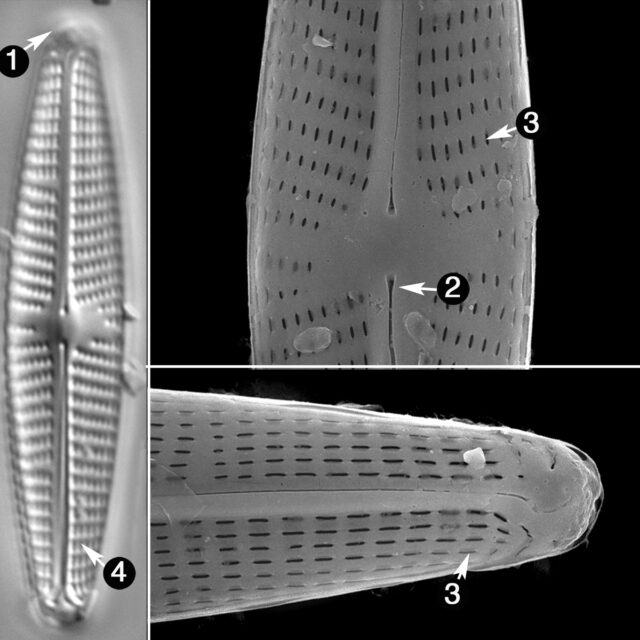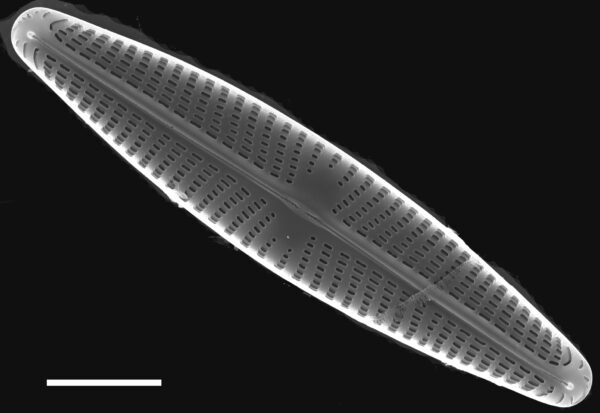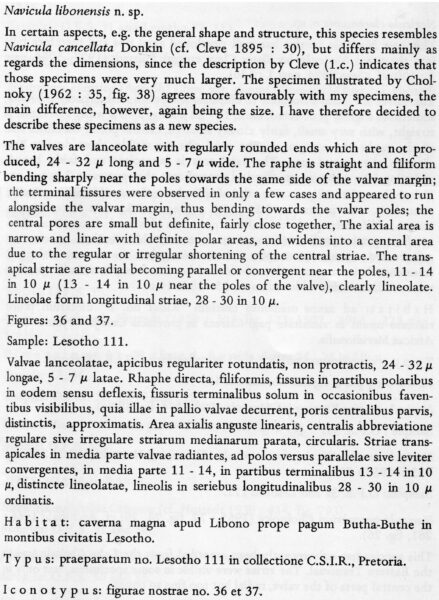Navicula libonensis
-
Category
-
Length Range27-35 µm
-
Width Range5.9-7.0 µm
-
Striae in 10 µm12-13
-
ContributorMarina Potapova - Feb 2011
-
ReviewerPat Kociolek - Apr 2011
Identification
Description
Valves are lanceolate with rounded or very slightly drawn-out ends. The axial area is narrow and linear. The central area is transversely elliptical or irregular-rectangular, often slightly asymmetrical. The proximal raphe ends are straight, slightly expanded. Terminal raphe fissures are hooked towards the secondary side. The lineolate striae are radiate, becoming convergent at the valve apices, 12-13 in 10 µm. The areolae are easily observed under LM, 28-32 in 10 µm.
Note that this concept of Navicula libonenesis follows Lange-Bertalot (2001), but the type material of this species have not been photographed. Therefore it is not clear at present whether North American, European, and South African populations represent the same species.
Autecology
In the EPA Western EMAP survey, this taxon was found in low gradient rivers, particularly in the Northern Great Plains. It was found in waters of high pH (often above 8), conductance, alkalinity, and phosphorus. It favored rivers with embedded substrates and was tolerant of turbid waters and human disturbance.
-
Size Range, µm3
-
Motility
-
Attachment
-
Habitat
-
Colony
-
Occurrence
-
BCG
-
Waterbody
-
Distribution
- Learn more about this
Original Description
The valves are lanceolate with regularly rounded ends which are not produced, 24-32 μ long and 5-7 μ wide. The raphe is straight and filiform bending sharply near the poles towards the same side of the valvar margin; the terminal fissures were observed in only a few cases and appeared to run alongside the valvar margin, thus bending towards the valvar poles; the central poles are small but definite, fairly close together, The axial area is narrow and linear with definite polar areas, and widens into a central area due to the regular or irregular shortening of the central striae. The transapical striae are radial becoming parallel or convergent near the poles, 11-14 in 10 μ (13-14 in 10 μ near the poles of the valve), clearly lineolate. Lineolae form longitudinal striae, 28-30 in 10 μ.
-
AuthorSchoeman 1970
-
Length Range24-32 µm
-
Width5-7 µm
-
Striae in 10µm11-14
Citations & Links
Citations
Links
-
Index Nominum Algarum
-
North American Diatom Ecological DatabaseNADED ID: 46542
Cite This Page
Potapova, M. (2011). Navicula libonensis. In Diatoms of North America. Retrieved April 25, 2024, from https://diatoms.org/species/navicula_libonensis
Responses
The 15 response plots show an environmental variable (x axis) against the relative abundance (y axis) of Navicula libonensis from all the stream reaches where it was present. Note that the relative abundance scale is the same on each plot. Explanation of each environmental variable and units are as follows:
ELEVATION = stream reach elevation (meters)
STRAHLER = distribution plot of the Strahler Stream Order
SLOPE = stream reach gradient (degrees)
W1_HALL = an index that is a measure of streamside (riparian) human activity that ranges from 0 - 10, with a value of 0 indicating of minimal disturbance to a value of 10 indicating severe disturbance.
PHSTVL = pH measured in a sealed syringe sample (pH units)
log_COND = log concentration of specific conductivity (µS/cm)
log_PTL = log concentration of total phosphorus (µg/L)
log_NO3 = log concentration of nitrate (µeq/L)
log_DOC = log concentration of dissolved organic carbon (mg/L)
log_SIO2 = log concentration of silicon (mg/L)
log_NA = log concentration of sodium (µeq/L)
log_HCO3 = log concentration of the bicarbonate ion (µeq/L)
EMBED = percent of the stream substrate that is embedded by sand and fine sediment
log_TURBIDITY = log of turbidity, a measure of cloudiness of water, in nephelometric turbidity units (NTU).
DISTOT = an index of total human disturbance in the watershed that ranges from 1 - 100, with a value of 0 indicating of minimal disturbance to a value of 100 indicating severe disturbance.

Navicula libonensis
- Ends rounded or very slightly protracted
- Proximal raphe ends straight
- Striae radiate at center, becoming convergent at apices
- Areolae visible in LM
Valves are lanceolate with rounded or very slightly drawn-out ends. The proximal raphe ends are straight and slightly expanded. The central area is transversely elliptical or irregular-rectangular, often slightly asymmetric. The lineolate striae are radiate, becoming convergent at the valve apices, 12-13 in 10 µm. The areolae are easily...
 Diatoms of North America
Diatoms of North America









